June 2016
Editor’s note: This article and the accompanying photos were submitted by Lauren Vuong, who was rescued by the SIU-crewed LNG Virgo decades ago. She is interested in hearing from anyone who was aboard the ship at that time, and may be reached by email at lauren.vuong@ gmail.com and by phone at (415) 603- 1025.
My Florida Reunion: 36 years of Gratitude to Seafarers
My family was rescued from the brink of death from the South China Sea in June 1980. My lifelong dream of meeting and thanking my family’s rescuers came true on March 26, 2016. Please join in my journey of survival, perseverance and gratitude.
The Past
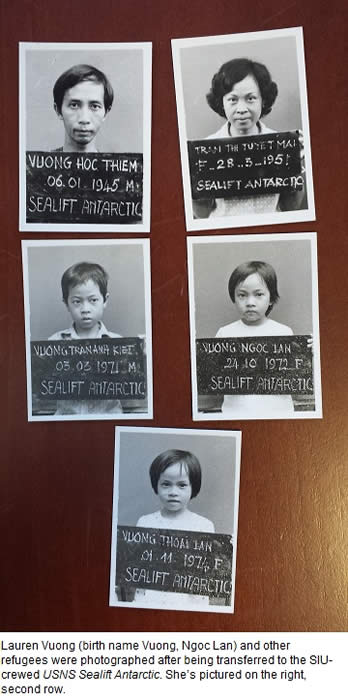 Imagine a little girl, three years old, who worships her father because he fights for his country. She tags along like his shadow whenever he’s home. One day she wakes up and finds him gone. She’s told that he will be away for a few months. Three years later, he’s still not home.One day, when the little girl is six, she walks all day with her mother and grandmothers on unpaved roads and plowed fields to the border between Vietnam and Cambodia. She’s told her father will be there and that she’ll see him. When she gets there, a barbed wire fence separates her and a man faintly resembling her father. She waits all day under the scorching sun. When her father finally approaches, he’s different, not the shining hero of her memory.
Imagine a little girl, three years old, who worships her father because he fights for his country. She tags along like his shadow whenever he’s home. One day she wakes up and finds him gone. She’s told that he will be away for a few months. Three years later, he’s still not home.One day, when the little girl is six, she walks all day with her mother and grandmothers on unpaved roads and plowed fields to the border between Vietnam and Cambodia. She’s told her father will be there and that she’ll see him. When she gets there, a barbed wire fence separates her and a man faintly resembling her father. She waits all day under the scorching sun. When her father finally approaches, he’s different, not the shining hero of her memory.
Next, imagine that same little girl, not yet eight years old, still missing some teeth. One night she and her family slip quietly out of their house without a single goodbye to anyone. They have in their possession: a small bag of dried foods, a few gold chains sewn into their hemlines, and her father’s army dog tag. They board a tiny fishing boat to flee communist Vietnam. They bring the dog tag to prove her father’s affiliation with the U.S. Army.
I was that little girl. My father, a captain in the South Vietnamese Army, was imprisoned for four years in a Vietcong reeducation camp after Saigon surrendered. As a child, I was not permitted to attend school because my father was “a traitor.” My family was under constant surveillance from our neighbors who would report even the most minor detail of our lives, like what we ate or what soap we bathed with. A few months after my father’s release in 1979, we were compelled to attend an execution of an accused subversive. The purpose of our mandatory attendance was to remind us that the same fate could befall my father.
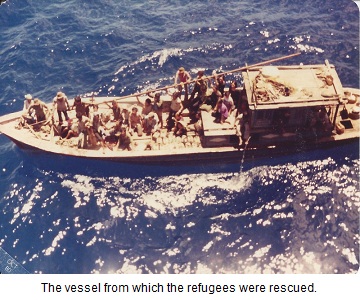 Our persecution was pervasive, unbearable and ceaseless. There was no future for my father and likely none for us. My parents realized with great sadness that the only option was to escape Vietnam.
Our persecution was pervasive, unbearable and ceaseless. There was no future for my father and likely none for us. My parents realized with great sadness that the only option was to escape Vietnam.
My parents and their trusted associates, some of whom were imprisoned with my father, meticulously planned the escape. They pooled money to buy a fishing boat, and secretly gathered emergency supplies like medicine and dried goods. Even the timing and route were carefully calculated.We left during the monsoon season and took the route commonly known as Typhoon Alley to the Philippines. We chose the longest route during the most dangerous time of the year because most of the families on my boat were high political risks, such as former military officers, governors and intellectuals. Capture would have likely resulted in a death sentence. We therefore hoped that by choosing such a dangerous time to leave, there would be less coastal patrol, thus helping us to elude capture. The estimated travel time was seven days in good weather.
The first two days of good weather allowed us to safely get to international waters and avoid capture. The next days are now a blur in my mind. What I do remember: the awful smells of human waste; the constant churning of my stomach; vomiting until I thought I would die. I remember the black walls of water that threatened to engulf our boat. I remember hunger so great that it took on its own shape: dark and twisting like a rope around all my organs. I remember my brother falling ill and others openly discussing what to do with his body if he were to die. I remember the desperation on my mother’s face as she looked at us, listless, starving and dehydrated.
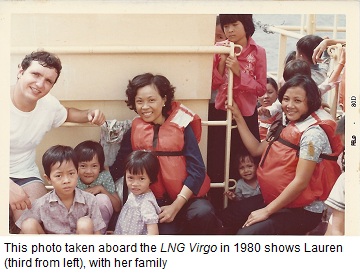 On the tenth morning, the skies cleared. We were lost, low on fuel, food and water. We understood our dire situation. Barring a miracle, imminent death was a certainty. As we floated hopelessly, a ship flying the U.S. flag spotted us and slowed down. We waved our arms, jumped up and down and prayed for rescue. That ship was the LNG Virgo, part of the SIU-contracted company Energy Transportation Corporation fleet which transported liquefied natural gas from Indonesia to Japan.We were rescued by the Virgo in June 1980. (Seafarer Don Hicks was the bosun, while L. Jarman was the chief steward.). There were 62 of us; 27 were children under 12 years old. After about a week on board the Virgo, we transferred to another SIU-crewed ship, the USNS Sealift Antarctic. At the time, I understood that the transfer was made for our benefit because following the United Nations’ Geneva Convention on the refugee crisis in July 1979, President Jimmy Carter ordered the Seventh Fleet operating in the South China Sea to look for and pick up “boat people.” Such an active decree by the president led us to believe that being under a U.S. Navy ship’s rescue (as opposed to a commercial vessel) would almost certainly ensure our refugee status and resettlement in America. In my mind, though, it did not matter whether the vessel was military or commercial. The undisputed fact was that we were saved by ships flying the American flag. That image forever cemented itself in my mind as synonymous with life and freedom.
On the tenth morning, the skies cleared. We were lost, low on fuel, food and water. We understood our dire situation. Barring a miracle, imminent death was a certainty. As we floated hopelessly, a ship flying the U.S. flag spotted us and slowed down. We waved our arms, jumped up and down and prayed for rescue. That ship was the LNG Virgo, part of the SIU-contracted company Energy Transportation Corporation fleet which transported liquefied natural gas from Indonesia to Japan.We were rescued by the Virgo in June 1980. (Seafarer Don Hicks was the bosun, while L. Jarman was the chief steward.). There were 62 of us; 27 were children under 12 years old. After about a week on board the Virgo, we transferred to another SIU-crewed ship, the USNS Sealift Antarctic. At the time, I understood that the transfer was made for our benefit because following the United Nations’ Geneva Convention on the refugee crisis in July 1979, President Jimmy Carter ordered the Seventh Fleet operating in the South China Sea to look for and pick up “boat people.” Such an active decree by the president led us to believe that being under a U.S. Navy ship’s rescue (as opposed to a commercial vessel) would almost certainly ensure our refugee status and resettlement in America. In my mind, though, it did not matter whether the vessel was military or commercial. The undisputed fact was that we were saved by ships flying the American flag. That image forever cemented itself in my mind as synonymous with life and freedom.
We transferred to the USNS Sealift Antarctic on July 3, 1980 and disembarked two days later in Singapore, many of us shoeless and still with only the clothes on our backs. We spent the next five months in a refugee camp in Galang, Indonesia, waiting for resettlement. We lived in a tinroofed army barrack with other families. There were 104 people in my barrack. There was no electricity or indoor plumbing in the camp. My family resettled in San Jose, California. My parents went to school in the daytime to learn English. At night, they went to trade school to learn electronics to work in the Silicon Valley. We cleaned houses on the weekends. My parents did everything they could to ensure our survival. My siblings and I were told never to squander the life our saviors gave us. We tried very hard in school; failure was not an option.
The Present
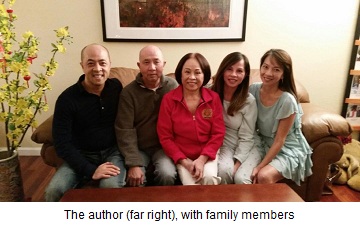 I am now a practicing attorney in San Francisco. My brother works in information technology in the Silicon Valley; my sister is a pharmacist in Westminster. Both my parents are in good health and enjoying their well-deserved retirement.
I am now a practicing attorney in San Francisco. My brother works in information technology in the Silicon Valley; my sister is a pharmacist in Westminster. Both my parents are in good health and enjoying their well-deserved retirement.
Since June 1980, the skyscraping image of the Virgo never left my mind. It was my lifelong dream to find and thank the captain and crew who saved us. I first started searching for the Virgo in 1991 when I was researching college scholarships. My mother said our saving vessel’s name is “Viet-go.” I could not find any such ship in the maritime registries.
In 2007, I realized that my mother was mispronouncing the ship’s name. I asked her to spell out “Viet-go;” she wrote “Virgo.”With the help of a researcher and the marvel of the internet, I located Captain George Overstreet. I initially thought Captain Overstreet was our rescuer. He clarified, however, that our benefactor was actually Captain Hartmann Schonn, who passed away in 2000. Though disappointed, I still wanted to find others who were present during our rescue. Captain Overstreet introduced me to retired Chief Engineer Don McLendon, who sailed with various ships in the ETC fleet and who had himself participated in several rescues. Don was still connected to many in the seafaring community and offered me his help.
Through the power of his MEBA and SIU contacts, Don tirelessly tracked down various leads to ascertain who was onboard the LNG Virgo in June 1980. We had a series of near hits and disappointments, each time more crushing than the previous. Don, however, refused to let me give up hope.
Don’s profound benevolence transformed my thinking. I realized that it was immaterial that he and George Overstreet were not actually on board at the time of my rescue. The gratitude I felt extended to all seafarers who rescued refugees in distress. I could not distinguish between the compassion extended to me and the one that benefitted others like me. In my mind, if they saved one Vietnamese boat person, that person could have been my father, my mother or someone I know. Without these generous seafarers, the Vietnamese- American community as we know it would not exist.
I expressed a desire to meet those who contributed to saving refugees. Captain Overstreet invited us to visit in Florida.
Miraculously, a week before our planned reunion, Don, with the assistance of the editors of the Marine Officer and Seafarers LOG, located archival articles documenting the LNG Virgo’s collaboration with USNS Sealift Antarctic to rescue a total of 185 boat people. One article mentioned Captain Hartman Schonn and his USNS Sealift Antarctic counterpart Master Douglass Torborg. Doug, incredibly, still retained a copy of the rescue ledger. He confirmed that my family was “Family #11” and that I was “#56” on the ledger.The next day yielded equally amazing news: Kenneth Nelson, then cargo engineer on board the Virgo, actually assisted in our rescue. He boarded our boat, assessed the situation and declared our vessel unseaworthy, thus clearing the way for rescue. Mr. Nelson stood on our boat, timed the sea swell and individually handed over every child to Assistant Engineer Dan Hanson waiting on the gangway. I contacted Engineer Nelson. During our conversation, Ken realized he still had the photos and sent them to me. My family stared in disbelief at our images from 36 years ago, the joy evident on our faces. Immense gratitude filled my heart.On March 26, 2016, we reunited with our saviors after 36 years. Words are inadequate to describe how we felt upon meeting George Overstreet, Don McLendon, Doug Torborg and their respective families. Tears flooded our eyes as we embraced the people who gave us life.
I individually asked Doug, Don and George about their experiences rescuing refugees from the South China Sea. McLendon emphatically refuses any credit. He claims that rescuing boats in distress is “the seafarer’s way.” Doug, when receiving belated accolades for his heroism at sea, said, “We were trained to render assistance to people and vessels in distress.… It was just part of our job.”George simply stated, “It was the right thing to do.”
The Future
I continue to be astounded by the seafaring community’s generosity. Without Don’s tireless efforts, my family would not have had the opportunity to thank our saviors for their compassion so many years ago. George hosted my party of six for five days in his home. Doug, Don and their respective wives gave up their weekend to see us.
I am grateful to be able to hold each of the mariner’s hands and tremble through the words that have been ever-present in my heart for the last 36 years, “Thank you.”The reunion was beyond any fantasy I could conjure as the bumbling 18 year-old searching for the Virgo in maritime registries. Yet, greedily perhaps, I persist in my desire to find others: Bill Hewitt, chief mate of the Virgo during my family’s rescue; Assistant Engineer Dan Hanson who assisted on the gangway, and all other yet-identified mates, engineers and unlicensed crewmen. From the USNS Sealift Antarctic: Second Mate Ed Wheeler, Third Engineer James Murphy, ABs Ed Marz and William Richardson, Third Mate and doctor Michael Carlisle, Chief Mate Thomas Jacobsen and Messmen Sebastian Terres and Ali Saeed. And most important personally, I wish to find Anna Carina Schonn, Captain Schonn’s daughter. I believe Anna Schonn currently lives in Germany. I very much wish to meet Ms. Schonn and tell her what her father’s immense compassion did for us. I know that my family’s reunion with our saviors after 36 years is not the end of the story, but rather the beginning of a new and continuing dialogue that connects our two communities. I hope that many more families will have the opportunity to express their gratitude as we have. Above all else, I hope that the children, grandchildren and great grandchildren of people like George Overstreet, Don McLendon, Douglas Torborg, Ken Nelson and so many others, will see the truly historic impact their fathers made on the history of an entire immigrant community for whom existence would not have been possible.
I am humbled. I am blessed. I am grateful.
# # #


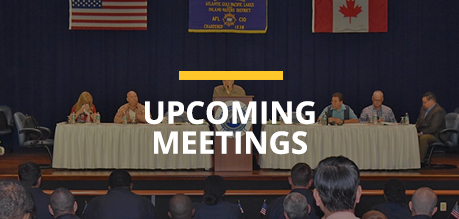
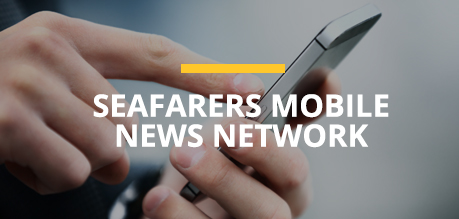
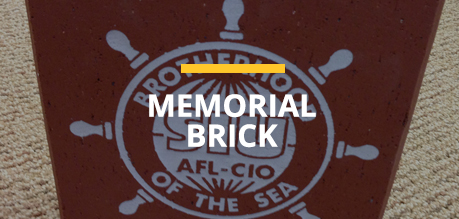
Comments are closed.